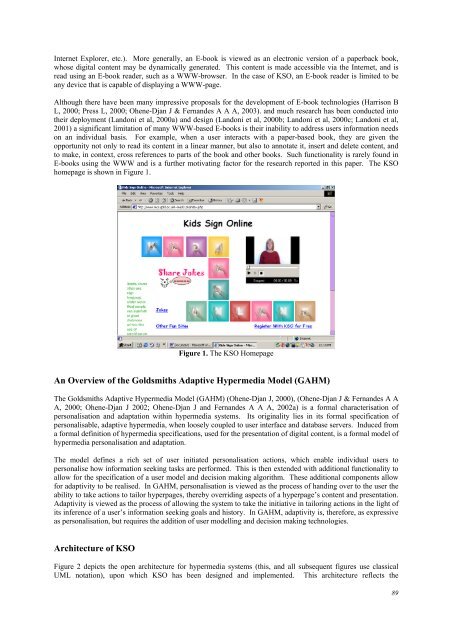A Personalisable Electronic Book for Video-based Sign Language ...
A Personalisable Electronic Book for Video-based Sign Language ...
A Personalisable Electronic Book for Video-based Sign Language ...
Create successful ePaper yourself
Turn your PDF publications into a flip-book with our unique Google optimized e-Paper software.
Internet Explorer, etc.). More generally, an E-book is viewed as an electronic version of a paperback book,<br />
whose digital content may be dynamically generated. This content is made accessible via the Internet, and is<br />
read using an E-book reader, such as a WWW-browser. In the case of KSO, an E-book reader is limited to be<br />
any device that is capable of displaying a WWW-page.<br />
Although there have been many impressive proposals <strong>for</strong> the development of E-book technologies (Harrison B<br />
L, 2000; Press L, 2000; Ohene-Djan J & Fernandes A A A, 2003). and much research has been conducted into<br />
their deployment (Landoni et al, 2000a) and design (Landoni et al, 2000b; Landoni et al, 2000c; Landoni et al,<br />
2001) a significant limitation of many WWW-<strong>based</strong> E-books is their inability to address users in<strong>for</strong>mation needs<br />
on an individual basis. For example, when a user interacts with a paper-<strong>based</strong> book, they are given the<br />
opportunity not only to read its content in a linear manner, but also to annotate it, insert and delete content, and<br />
to make, in context, cross references to parts of the book and other books. Such functionality is rarely found in<br />
E-books using the WWW and is a further motivating factor <strong>for</strong> the research reported in this paper. The KSO<br />
homepage is shown in Figure 1.<br />
Figure 1. The KSO Homepage<br />
An Overview of the Goldsmiths Adaptive Hypermedia Model (GAHM)<br />
The Goldsmiths Adaptive Hypermedia Model (GAHM) (Ohene-Djan J, 2000), (Ohene-Djan J & Fernandes A A<br />
A, 2000; Ohene-Djan J 2002; Ohene-Djan J and Fernandes A A A, 2002a) is a <strong>for</strong>mal characterisation of<br />
personalisation and adaptation within hypermedia systems. Its originality lies in its <strong>for</strong>mal specification of<br />
personalisable, adaptive hypermedia, when loosely coupled to user interface and database servers. Induced from<br />
a <strong>for</strong>mal definition of hypermedia specifications, used <strong>for</strong> the presentation of digital content, is a <strong>for</strong>mal model of<br />
hypermedia personalisation and adaptation.<br />
The model defines a rich set of user initiated personalisation actions, which enable individual users to<br />
personalise how in<strong>for</strong>mation seeking tasks are per<strong>for</strong>med. This is then extended with additional functionality to<br />
allow <strong>for</strong> the specification of a user model and decision making algorithm. These additional components allow<br />
<strong>for</strong> adaptivity to be realised. In GAHM, personalisation is viewed as the process of handing over to the user the<br />
ability to take actions to tailor hyperpages, thereby overriding aspects of a hyperpage’s content and presentation.<br />
Adaptivity is viewed as the process of allowing the system to take the initiative in tailoring actions in the light of<br />
its inference of a user’s in<strong>for</strong>mation seeking goals and history. In GAHM, adaptivity is, there<strong>for</strong>e, as expressive<br />
as personalisation, but requires the addition of user modelling and decision making technologies.<br />
Architecture of KSO<br />
Figure 2 depicts the open architecture <strong>for</strong> hypermedia systems (this, and all subsequent figures use classical<br />
UML notation), upon which KSO has been designed and implemented. This architecture reflects the<br />
89
















